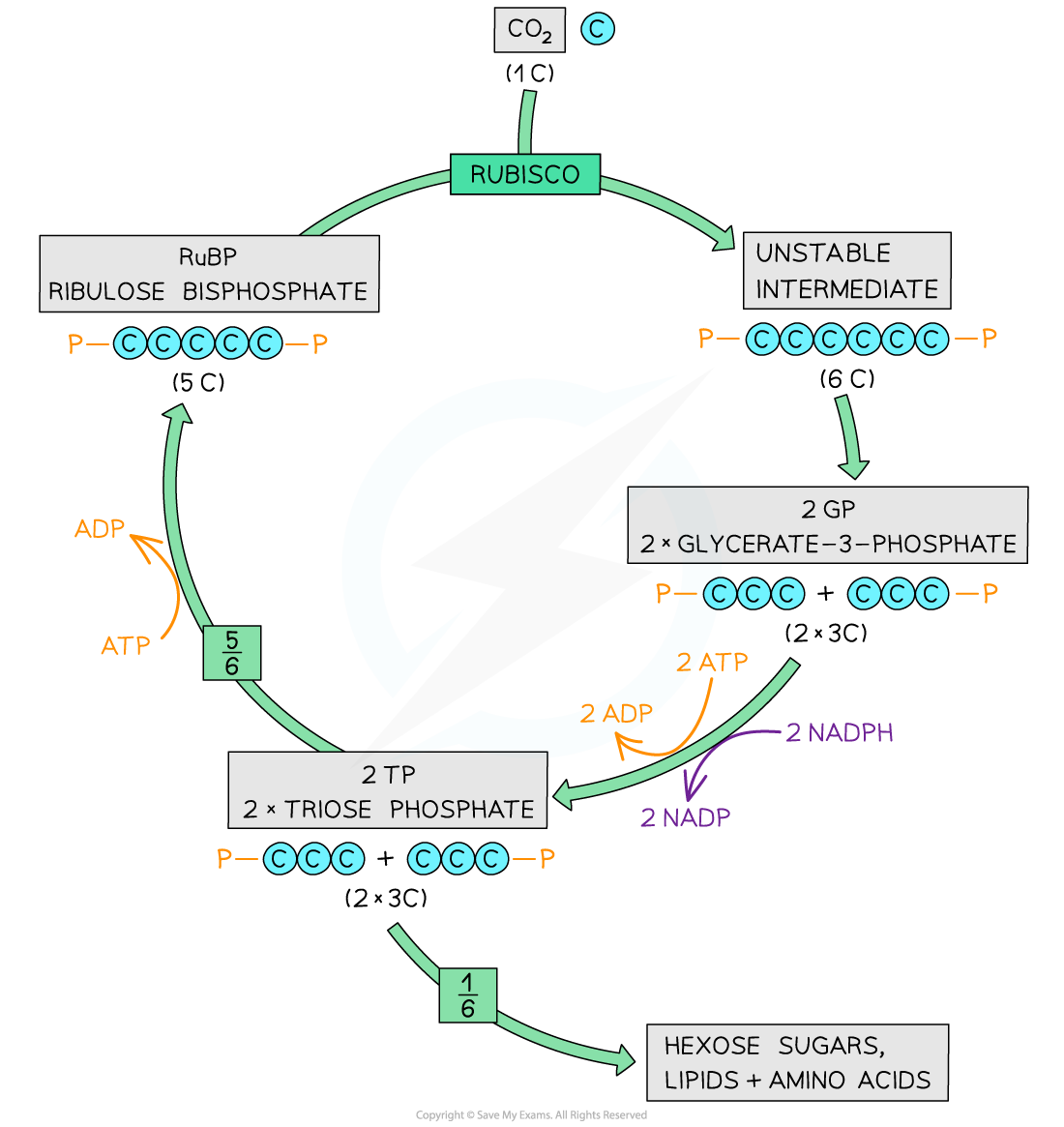Location of the Light-independent Reactions
- The light-independent reactions of photosynthesis take place in the stroma of the chloroplasts
- The stroma is within the double membrane and is a thick protein rich environment containing the enzymes needed for the light-independent reactions
Carbon Fixation
- The light-independent reactions of photosynthesis are also known as the Calvin cycle
- Carbon dioxide is converted into carbohydrates, namely glucose, during the cycle in a series of anabolic reactions
- Anabolic reactions require energy in order to build large complex molecules from smaller simpler ones
- The Calvin cycle relies on the products of the light-dependent reactions namely ATP and reduced NADP
- During the cycle endergonic reactions take place that involve the hydrolysis of ATP and oxidation of reduced NADP
- An endergonic reaction requires energy to be absorbed before the reaction can proceed
- There are three main steps within the Calvin cycle:
- The enzyme rubisco catalyses the fixation of carbon dioxide by combination with a molecule of ribulose bisphosphate (RuBP), a 5C compound, to yield two molecules of glycerate 3-phosphate (GP), a 3C compound
- GP is reduced to triose phosphate (TP) in a reaction involving reduced NADP and ATP
- RuBP is regenerated from TP in reactions that use ATP
Carbon fixation
- Carbon dioxide is the source of carbon for all organisms that carry out photosynthesis
- Carbon fixation involves carbon dioxide (1C) being removed from the external environment and becoming part of the plant, and is then said to be “fixed”
- It is transformed into a three-carbon compound (3C) called glycerate-3-phosphate (sometimes shortened to as GP)
- During the fixation step of the Calvin cycle carbon dioxide is combined with a five-carbon compound (5C) called ribulose bisphosphate (RuBP) to make an unstable six-carbon (6C) compound that splits into two molecules of glycerate-3-phosphate
- This reaction is catalysed by the enzyme rubisco
- Glycerate-3-phosphate is then used in the next step of the cycle
Role of Reduced NADP and ATP
- Energy from ATP and hydrogen from reduced NADP (from the light-dependent reactions) are used to reduce glycerate-3-phosphate to a phosphorylated three-carbon molecule called triose phosphate (sometimes shortened to TP)
- After the reduction step one sixth of the triose phosphate is converted into usable products for the plant:
- Hexose phosphates which can be used to produce carbohydrates such starch, sucrose or cellulose
- Glycerol and fatty acids which join to form cell membranes
- Production of amino acids for protein synthesis
- It is important that not all the triose phosphate is converted to alternative compounds for the plant, or the supplies of ribulose bisphosphate would run out
- The remaining triose phosphate is used to regenerate RuBP
Exam Tip
For the Calvin cycle to continue it needs a constant supply of RuBP and carbon dioxide. As much RuBP must be produced as is consumed. If three RuBP molecules are used then this generates six triose phosphates. Five of the triose phosphate molecules are needed to regenerate the three RuBPs molecules. So there would only be one left over to convert into other usable molecules for the plant (such as starch). To produce just one molecule of glucose, six turns of the Calvin cycle are needed.
Regeneration of RuBP
- The remaining five sixths of triose phosphate are used to regenerate the four-carbon compound ribulose bisphosphate (RuBP)
- This process requires ATP (from the light-dependent reaction)
- Once RuBP been has regenerated it can go on to fix further carbon dioxide and the cycle can begin again

The Calvin cycle of the light-independent reactions showing the regeneration of RuBP